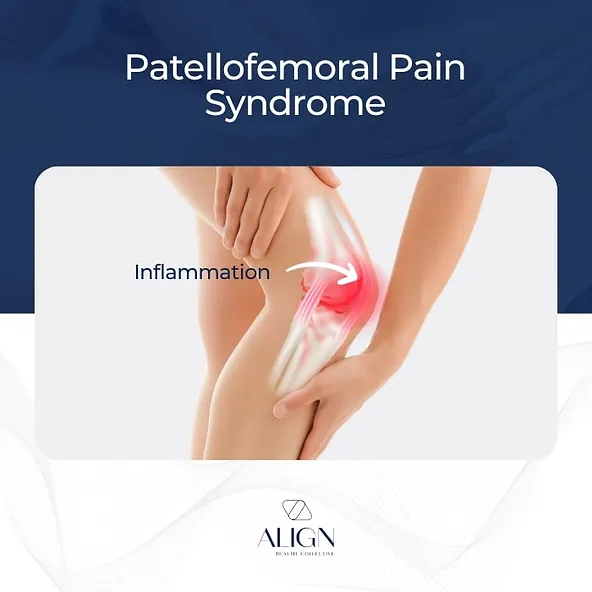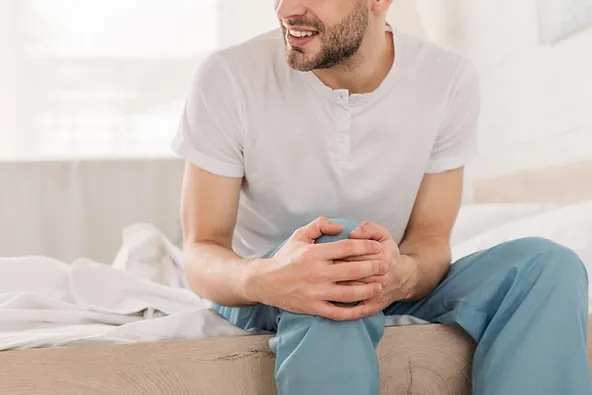
Patellofemoral Pain Syndrome (PFPS) is a pain in the front of your knee, around the kneecap (patella). That’s why it’s sometimes called runner’s knee. PFPS can really cramp your style, making it tough to run, climb stairs, sit for long stretches, or squat comfortably.
The good news is, PFPS can often be treated with simple things like rest and icing your knee. Physical therapy can also be a big help.
Here at Align Health Collective, we can help you get back on your feet! We offer treatments specifically for PFPS. Contact us today and let’s get you moving again!
Common Aliases and Related Conditions
Explore the various names and conditions related to PFPS, helping readers identify the syndrome even if another term refers to it.
- Runner’s Knee
- PFPS
- Femoropatellar Pain Syndrome
- Patellar Pain Syndrome
Causes of Patellofemoral Pain Syndrome or Runner’s Knee Syndrome
| Cause | Description |
| Overuse | Repetitive stress on the knee from activities like jogging, squatting, or climbing stairs. Sudden changes in activity frequency, duration, or intensity can also contribute. |
| Improper Training Techniques or Equipment | Using incorrect sports training methods or poorly fitted equipment can lead to PFPS. |
| Footwear or Playing Surface Changes | Switching to new shoes or playing on a different surface can sometimes trigger pain. |
| Patellar Malalignment | Abnormal tracking of the kneecap in the trochlear groove can cause irritation to soft tissues. |
| Leg Alignment Problems | Misalignment between hips and ankles can cause the kneecap to shift out of position. See our Biomechanical Assessment page for more information. |
| Muscular Imbalances or Weaknesses | Weak or imbalanced quadriceps muscles can affect kneecap tracking. |
Symptoms of Patellofemoral Pain Syndrome
| Symptom | Description |
| Dull Aching Pain | This pain is usually located in the front of the knee and may occur in one or both knees. It often develops gradually and worsens with activity. |
| Knee Pain After Running or During Activity | Activities that bend the knee repeatedly, like climbing stairs, sore knees after running, or squatting, can trigger pain. |
| Pain After Sitting | Sitting for long periods with bent knees can cause pain in the front of the knee. |
| Activity-Related Pain | Changes in activity level, intensity, playing surface, or equipment can worsen pain. |
| Popping or Crackling Sounds | Clicking or popping sounds in the knee can sometimes occur when climbing stairs or standing up after sitting for a long time. |

Treatment Options for Patellofemoral Pain Syndrome
Patellofemoral pain syndrome (PFPS) can sideline you from your favourite activities. Thankfully, there are several effective treatment options available, most of which don’t involve surgery. Let’s explore some ways to fight back and get you moving comfortably again.
Treatment at Home
Often, simple home remedies can make a big difference. The RICE method (Rest, Ice, Compression, Elevation) is a great place to start. Reduce activities that aggravate your knee, and swap them for low-impact exercises like swimming or cycling. Losing weight, if needed, can also lessen stress on the joint. Over-the-counter pain relievers like ibuprofen can help manage inflammation and discomfort.
Physical Therapy & Orthotics
If home remedies aren’t enough, your doctor can offer additional support. Physical therapy is the most important for of PFPS treatment. Therapists design personalised exercise programs to improve your range of motion, strengthen key muscles (especially your quadriceps), and enhance endurance. Core strengthening exercises may also be included to improve overall stability.
Orthotics, shoe inserts that realign and stabilise your foot and ankle, can take pressure off your lower leg and help with pain management. These can be custom-made for your specific needs or purchased over-the-counter.
Surgery
Thankfully, surgery for PFPS is rarely necessary. However, if all other treatments fail and your pain continues to impact your life significantly, your doctor may discuss surgical options.
By combining these treatment approaches, you can effectively manage PFPS and get back to enjoying your activities. Remember, early diagnosis and intervention are key to a successful recovery.
How to Prevent Knee Cap Pain?
Here are some key strategies to keep your knees healthy and avoid that unwanted ache around your kneecap.
Build Strength and Flexibility
The muscles around your knee, especially the quadriceps (front of the thigh) and hamstrings (back of the thigh), play a crucial role in supporting your kneecap. Regularly incorporating exercises that strengthen and stretch these muscles can significantly reduce your risk of PFPS. Leg extensions, a common physical therapy exercise, are a great example of a quadriceps strengthener. Don’t forget about stretching! Stretching your quads and hamstrings before and after activity helps maintain flexibility and proper knee tracking.
Listen to Your Body
It’s tempting to push yourself, but gradually increasing the intensity and duration of your workouts is essential for preventing knee pain. If a particular activity aggravates your knees, take a break or modify it to minimise stress on the joint. Remember, consistency is key – regular moderate exercise is better than sporadic bursts of intense activity.
Wear the Correct Shoes
Wearing shoes designed for your specific activity provides proper support and helps prevent abnormal forces on your knees. Whether you’re a runner, hiker, or gym enthusiast, invest in footwear that matches your needs. If you are unsure of what is the best footwear for you, you can read our footwear advice here or contact us directly.
Weight Management
Maintaining a healthy weight takes pressure off your knees, reducing the risk of PFPS and other knee problems. Even a modest weight loss can make a big difference.
Warm Up and Cool Down
Don’t jump straight into strenuous activity. A proper warm-up that includes light cardio and dynamic stretches prepares your muscles and joints for movement. Similarly, cool down with static stretches after your workout to help your body recover properly.
By incorporating these preventive measures into your routine, you can significantly reduce your chances of developing PFPS and keep your knees happy for years to come
FAQs About Patellofemoral Pain Syndrome or Runner’s Knee Syndrome
Does patellofemoral syndrome go away?
Yes, with the correct physical therapy and combination of treatment, your patellofemoral syndrome pain syndrome will go away.
How long does patellofemoral take to heal?
While highly dependent on the person, you can heal from Patellofemoral Pain in as little as six weeks with the correct combination of treatment, which may include physical therapy, exercise, and medication. The healing time may be longer if you’ve had surgery to manage your patellofemoral pain syndrome.
How should I sit with patellofemoral pain syndrome?
You should avoid sitting with your knees bent for long periods. Straighten one leg at a time, or prop yourself up on a chair edge to reduce knee flexion.
Back to top: What is Patellofemoral Pain Syndrome (Runner’s Knee)?
